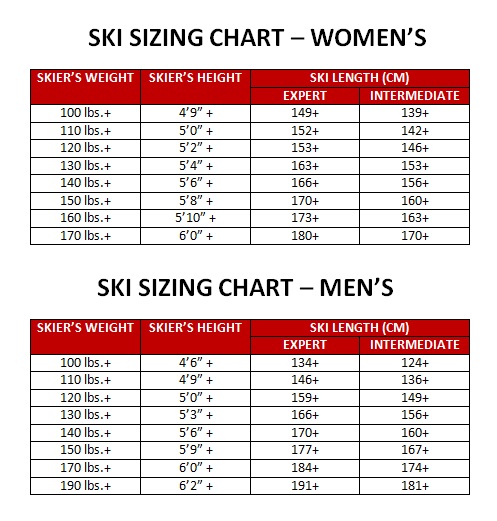Ski Length: Conquer the Slopes Like a Pro (or at Least Don't Faceplant)
So, you're ready to shred some gnar, huh? But wait, before you launch yourself down a double black diamond, let's talk about something crucial: your skis. Specifically, how long those planks should be. Picking the correct downhill ski length isn't just about looking cool (although that's a factor, let's be real). It's about control, stability, and avoiding a yard sale of epic proportions.
Choosing the ideal ski size is a bit like Goldilocks trying porridge: not too long, not too short, but just right. Too-long skis can be unwieldy and difficult to maneuver, especially for beginners. Too-short skis, on the other hand, might feel twitchy and unstable at higher speeds. So, how do you find that sweet spot? Well, buckle up, buttercup, because we're about to dive deep into the world of ski sizing.
For decades, the standard advice was to hold a ski upright and make sure the tip reached somewhere between your chin and forehead. That's a decent starting point, but it's overly simplistic. These days, the calculation is a bit more nuanced, taking into account factors like your skiing ability, weight, height, skiing style, and even the type of terrain you prefer. Thankfully, we’re living in the future, and there are charts and calculators galore to help you navigate this snowy minefield.
Back in the day, skis were long, heavy, and straight. Turning was a feat of strength and willpower. But with advancements in ski technology, like parabolic shaping and lighter materials, ski lengths have generally decreased. This allows for easier turning and more maneuverability, even at higher speeds. So, grandma's skis are probably not the best choice for your first time on the slopes.
Getting the right ski length is paramount for a good skiing experience. It directly impacts your ability to control your skis, maintain balance, and carve those glorious turns. Imagine trying to steer a bus down a mountain – that’s what skiing on skis that are too long can feel like. Conversely, imagine trying to control a skateboard on a bumpy road – that's what it's like to ski on skis that are too short at speed.
Determining the appropriate downhill ski length is more of an art than a science. It’s a balancing act between several factors. While height and weight are primary, skill level is equally important. A beginner might opt for shorter skis for easier turning, while an expert carving up black diamonds might prefer longer, more stable skis. Terrain also plays a role: powder hounds might prefer longer, wider skis for floatation, while park rats might favor shorter, more nimble skis for tricks.
Here are some general guidelines: For beginners, aim for skis that reach somewhere between your chin and forehead when stood on end. Intermediates should look for skis that come up to around their nose or eyes. Advanced skiers might choose skis that reach their forehead or slightly above. Remember, these are just guidelines, and other factors, like weight and skiing style, can influence your ideal ski length.
Benefits of Choosing the Right Ski Length:
1. Improved Control: Skis of the correct length allow for precise and effortless maneuvering. Example: Imagine carving smooth turns with ease, like a graceful swan on ice.
2. Enhanced Stability: Appropriately sized skis provide a stable platform, especially at higher speeds. Example: Bombing down a steep slope with confidence, feeling like a superhero.
3. Reduced Fatigue: Skis that are too long or too short can lead to muscle strain and fatigue. Example: Enjoy a full day on the slopes without feeling like you ran a marathon.
Advantages and Disadvantages of Different Ski Lengths
| Ski Length | Advantages | Disadvantages |
|---|---|---|
| Shorter | Easier turning, maneuverability, ideal for beginners and park skiing | Less stable at high speeds, less float in powder |
| Longer | Greater stability at high speeds, better float in powder, ideal for advanced skiers | More difficult to turn, less maneuverable |
FAQ:
1. Q: What if I'm between sizes? A: Consider your skiing style and the type of terrain you prefer.
2. Q: Do ski length recommendations change for children? A: Yes, children typically use shorter skis based on their height and weight.
3. Q: Can I use the same skis for all types of skiing? A: While possible, specialized skis exist for different disciplines like powder, park, and racing.
4. Q: How often should I replace my skis? A: It depends on usage, but generally, every few years is a good idea.
5. Q: Should I demo skis before buying? A: Absolutely! Demoing is the best way to find the perfect ski for you.
6. Q: What about ski width? A: Ski width is also important, especially for off-piste skiing. Wider skis provide better floatation in powder.
7. Q: Do I need special skis for moguls? A: Shorter, more maneuverable skis are generally preferred for mogul skiing.
8. Q: What about ski boots? A: Proper fitting ski boots are essential for comfort and performance. Don't skimp on boot fitting!
In conclusion, choosing the right downhill ski length is a crucial step in maximizing your skiing experience. It's about finding that Goldilocks zone – not too long, not too short – that allows you to control your skis with confidence and grace. From navigating beginner slopes to conquering challenging terrain, the right ski length will empower you to enjoy the mountain to the fullest. Don't underestimate the impact of this seemingly simple decision. So, do your research, consider your individual needs, and don't be afraid to ask for expert advice. Your perfect ski is out there, waiting to take you on an epic adventure.
The evolving landscape computrabajo remoto part time
Dominion energy outages in south carolina a comprehensive guide
Watercolor dreams why retro tiktok logos are a whole vibe












